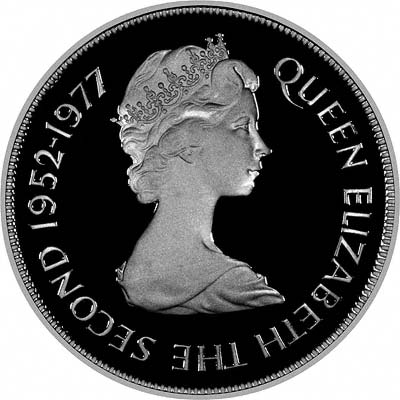| The Very Highest Quality Information... |
| Gibraltarian Coins |
|
| ||||||||||||||||||||||||||||||||||||
 Obverse of 1977 Gibraltar Silver Jubilee Crown | ||||||||||||||||||||||||||||||||||||
|
| ||||||||||||||||||||||||||||||||||||
 Reverse of 1977 Gibraltar Silver Jubilee Crown | ||||||||||||||||||||||||||||||||||||
Early History of Gibraltar
Gibraltar was for many years part of whichever state owned the neighbouring portion of Spain, and hence has been occupied (or at least owned) by the Phoenicians, Romans, Visigoths, Moors and Castilians (now the Kingdom of Spain).
Treaty of Utrecht
In 1704, Gibraltar was captured by a combined force of Anglo-Dutch Marines during the War of Spanish Succession. It was formally ceded to Britain by Spain in the Treaty of Utrecht, signed in 1713. Many of the original Spanish inhabitants left following the capture of the Rock, and Gibraltar became home to many different travellers, refugees and merchants from around the Mediterranean Basin.
Spain's loss of Gibraltar remained a source of resentment however, and Spain made several attempts to reconquer Gibraltar, the most notable of which took place during the American War of Independence in 1779, during the Great Siege of Gibraltar, which lasted for three and a half years. Despite the fact that Britain lost this war overall, she managed to retain Gibraltar as part of the peace agreement.
Strategic Value
Spain's struggles to recapture Gibraltar demonstrated its fortress-like qualities. Its position gave the Royal Navy greater access to the Mediterranean, and this became even more important when the Suez Canal opened in 1869, providing a short cut to India. Gibraltar, along with Malta and Cyprus, became the key bases providing supplies and fleet protection for convoys going to and from Britain's Eastern possessions via the Suez Canal.
Gibraltar in the 20th Century and the Present Day
During the Second World War, Gibraltar was vitally important as a naval and air base, as it made it very difficult for German U-boats to enter or exit the Mediterranean. Although some U-boats did manage to slip past and enter the Mediterranean via Gibraltar, none ever made it out again.
Following the end of the British Empire in the later part of the 20th Century and the end of the Cold War, Gibraltar's strategic importance is no longer as great as it once was, particularly as Spain is now a member of NATO.
However, the inhabitants of the Rock have consistently turned down any proposal to hand the territory back to Spain, much to the chagrin of both British and Spanish Officials who regard the issue as a blight on good Anglo-Spanish relations. The last referendum on the issue was held in 2002. Where a resounding 98.43% of Gibraltarians rejected an Anglo-Spanish proposal that sovereignty be shared between Britain and Spain.
Coinage of Gibraltar
In the first few years of British rule, Spanish currency continued to be used there, although unlike Spain the authorities made no distinction between de vellon (billon) and silver (de plata or silver). From 1741 a system was established whereby 2 blancas = 1 maravedi, 4 maravedi = 1 quarto/quart, 16 quartos = 1 real de vellon, 8 reales de vellon = 1 peso sencillo ('current' dollar) and 10 realles de vellon = 1 peso de plata (silver dollar). Most coins in circulation tended to be billon or copper, as good silver coins tended to disappear quite quickly into the Spanish mainland. Coin shortages led to the issue of merchant tokens, as had happened in Britain during the late 18th and early 19th centuries.
In 1825, the Gibraltar real was revised and pegged to the Pound Sterling. The Real de Plata was divided into 24 quarts, with 96 maravedies to the real, compared to 85 to the real in Spain. British coins were introduced, but were slightly over valued and therefore did not circulate. British copper coins did however circulate, and the British farthing was informally valued at 1 quart.
The Gibraltar real was abolished in 1872 and Spanish currency became sole legal tender there. However, in 1898, the Spanish-American War caused a collapse in the value of the Peseta, and the Pound Sterling was introduced as sole legal tender.
Although certain denominations (such as the three-halfpence, quarter and half-farthings) were introduced specifically for Gibraltar and Malta, Gibraltar did not issue its own coins until 1988, featuring the Gibraltar coat of arms on the reverse. Although they are pegged at par to the UK pound, Gibraltarian coins are not legal tender in the UK, although they are often found in circulation here and generally accepted by most UK shopkeepers.
For Sale and Wanted
If you are interested in coins from Gibraltar please see our product index:-
Gibraltarian Coins
| ...at the Lowest Possible Price |
|
32 - 36 Harrowside, Blackpool, Lancashire, FY4 1RJ, England.
Telephone (44) - (0) 1253 - 343081 ; Fax 408058; E-mail: info@chards.co.uk The URL for our main page is: https://24carat.co.uk |
Web Design by Snoop |